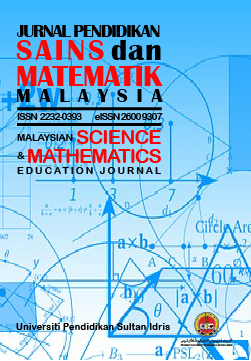An Analysis of Students’ Understanding of Algebraic Concepts
DOI:
https://doi.org/10.37134/jpsmm.vol13.2.8.2023Keywords:
algebra, quadratic equations, quadratic inequalities, quadratic graphs, students’ understandingAbstract
Teaching algebraic topics needs more exceptional efforts to make connections among the topics. Prior research has emphasised students' accomplishments in specific subject areas, but there is a deficiency in analysing students' skills in a few related subject areas. This study seeks to determine the extent to which students comprehend the relationship between the topics. A paper-and-pencil examination was administered to 102 pupils from two private secondary schools in Malaysia using a case study. Five respondents were selected to be interviewed regarding their understanding of these topics. This study revealed the efforts made by students to improve their understanding of algebra. A comparison was made between their algebraic knowledge as it pertained to quadratic equations, inequalities, and graphs. Their limited understanding of graphical knowledge in comparison to quadratic equations and inequations influences the decision of the necessary steps for the fundamental components of quadratic mathematics. As there are connections between the topics, this study suggests that students can bridge gaps between their current algebraic knowledge and their graphic comprehension of quadratic functions, equations, and inequalities through discourse and interactive activities.
Downloads
References
Adnan, M. et al. (2018) ‘Pembinaan item kemahiran berfikir aras tinggi Matematik Tingkatan Satu untuk topik Pecahan’, Jurnal Pendidikan Sains Dan Matematik Malaysia, 8(1), pp. 46–54. https://doi.org/10.37134/jpsmm.vol8.1.4.2018.
Aziz, T. A., Pramudiani, P., Purnomo, Y. W., Hamka, D., Tanah Merdeka, J., Rebo, P., & Timur, J. (2018). Differences between quadratic equations and functions: Indonesian pre-service secondary mathematics teachers’ views. Journal of Physics: Conference Series, 948(1), 012043. https://doi.org/10.1088/1742-6596/948/1/012043
Baiduri, B. (2020). Students’ strategy in connecting fractions, decimal, and percent in solving visual form problems. Universal Journal of Educational Research, 8(11), 5361–5366. https://doi.org/10.13189/UJER.2020.081138
Binkley, C. (2023). College students are still struggling with basic math. Professors blame the pandemic | AP News. https://apnews.com/article/college-math-test-help-6cca6a5e873d5aeb5e75b4f94125d48c
Gagne, R. (1985). The Conditions of Learning (4th Ed.). New York: Holt, Rinehart & Winston.
García-García, J., & Dolores-Flores, C. (2021). Pre-university students’ mathematical connections when sketching the graph of derivative and antiderivative functions. Mathematics Education Research Journal, 33(1), 1–22. https://doi.org/10.1007/S13394-019-00286-X/METRICS
Grewal, A. S. (1994). Concept development in mathematics : teaching and learning of quadratic equations, inequalities and their graphs. [University of Kwazulu-Natal]. https://researchspace.ukzn.ac.za/handle/10413/3207
Hattikudur, S., & Alibali, M. W. (2011). The Role of Comparison in Mathematics Learning. Proceedings of the Annual Meeting of the Cognitive Science Society, 33(33).
Hoon, T. S., Singh, P., & Halim, U. K. A. (2018). Understanding of Function and Quadratic Function among Secondary School Students in Selangor. Asian Journal of University Education, 14(1). https://eric.ed.gov/?id=EJ1207803
Jacobs Danan, J. A., & Gelman, R. (2018). The problem with percentages. Philosophical Transactions of the Royal Society B: Biological Sciences, 373(1740). https://doi.org/10.1098/RSTB.2016.0519
Joshi, T. Raj. (2019). Investigating Students’ Mathematical Difficulties in Quadratic Equations at Grade Ix - Penelusuran Google [Tribhuvan University]. https://research-repository.griffith.edu.au
Kamaluddin, M., & Widjajanti, D. B. (2019). The Impact of Discovery Learning on Students’ Mathematics Learning Outcomes. Journal of Physics: Conference Series, 1320(1), 012038. https://doi.org/10.1088/1742-6596/1320/1/012038
Kotsopoulos, D. (2007). Unravelling Student Challenges with Quadratics: A Cognitive Approach. Australian Mathematics Teacher, 63(2), 19–24.
Mainali, B. (2021). Representation in Teaching and Learning Mathematics. International Journal of Education in Mathematics, Science and Technology, 9(1), 1–21. https://doi.org/10.46328/IJEMST.1111
Makonye, J., & Shingirayi, M. (2014). The Obstacles Faced by the Learners in the Learning of Quadratic Inequalities. Mediterranean Journal of Social Sciences, 5(27), 716–725. https://doi.org/10.5901/MJSS.2014.V5N27P716
Mohd. Tajudin, N., Puteh, M., Adnan, M., Lee Abdullah, M. F. N., & Ibrahim, A. (2015). Perception and practice of teaching Mathematics in solving algebra problems. Jurnal Pendidikan Sains Dan Matematik Malaysia, 5(2), 12–22. https://ejournal.upsi.edu.my/index.php/JPSMM/article/view/2148
O’Connor, B. R., & Norton, S. (2022). Exploring the challenges of learning quadratic equations and reflecting upon curriculum structure and implementation. Mathematics Education Research Journal. https://doi.org/10.1007/s13394-022-00434-w
Poçan, S., Altay, B., & Yaşaroğlu, C. (2023). The Effects of Mobile Technology on Learning Performance and Motivation in Mathematics Education. Education and Information Technologies, 28(1), 683–712. https://doi.org/10.1007/s10639-022-11166-6
Pape, S. J., & Tchoshanov, M. A. (2001). The role of representation(s) in developing mathematical understanding. Theory into Practice, 40(2), 118–127. https://doi.org/10.1207/S15430421TIP4002_6/ASSET//CMS/ASSET/DE3D9AF9-600E-4A33-A2CF-EE09D06B8AA4/S15430421TIP4002_6.FP.PNG
Prasad, K. S. (1970). Learning Mathematics by Discovery. Academic Voices: A Multidisciplinary Journal, 1, 31–33. https://doi.org/10.3126/AV.V1I0.5307
Poçan, S., Altay, B., & Yaşaroğlu, C. (2023). The Effects of Mobile Technology on Learning Performance and Motivation in Mathematics Education. Education and Information Technologies, 28(1), 683–712. https://doi.org/10.1007/s10639-022-11166-6
Rodríguez-Nieto, C. A., Font Moll, V., Borji, V., & Rodríguez-Vásquez, F. M. (2022). Mathematical connections from a networking of theories between extended theory of mathematical connections and onto-semiotic approach. International Journal of Mathematical Education in Science and Technology. https://doi.org/10.1080/0020739X.2021.1875071
Skemp, R. R. (1971). The psychology of learning mathematics. 319. https://books.google.com/books/about/The_Psychology_of_Learning_Mathematics.html?hl=id&id=0y84AAAAMAAJ
Spitzer, M., Ruiz-Garcia, M., Strittmatter, Y., & Moeller, K. (2023). On the difficulty of rational number formats. PsyArXiv Preprints. https://doi.org/10.31234/OSF.IO/7QEBN
Star, J. R., Foegen, A., Larson, M. R., McCallum, W. G., Porath, J., & Zbiek, R. (2019). Teaching strategies for improving algebra knowledge in middle and high school students (NCEE 2015-4010). U.S. Department of Education, Institute of Education Sciences, National Center for Education Evaluation and Regional Assistance. https://www.education.ne.gov
Tsamir, P., & Almog, N. (2001). Students’ strategies and difficulties: the case of algebraic inequalities. International Journal of Mathematical Education in Science and Technology, 32(4), 513–524. https://doi.org/10.1080/00207390110038277
Vedran, K., Škrinjarić, T., Vedran, K., & Škrinjarić, T. (2019). A note on the turning point for the quadratic trend. Croatian Review of Economic, Business and Social Statistics, 5(2), 39–48. https://doi.org/10.2478/CREBSS-2019-0010
Downloads
Published
Issue
Section
License
Copyright (c) 2023 Nur Nadira Ashyikin Muhammad Fuad Tiew, Sian Hoon Teoh, Parmjit Singh Aperapar Singh, Sikky El Walida, Surya Sari Faradiba

This work is licensed under a Creative Commons Attribution-NonCommercial-ShareAlike 4.0 International License.





